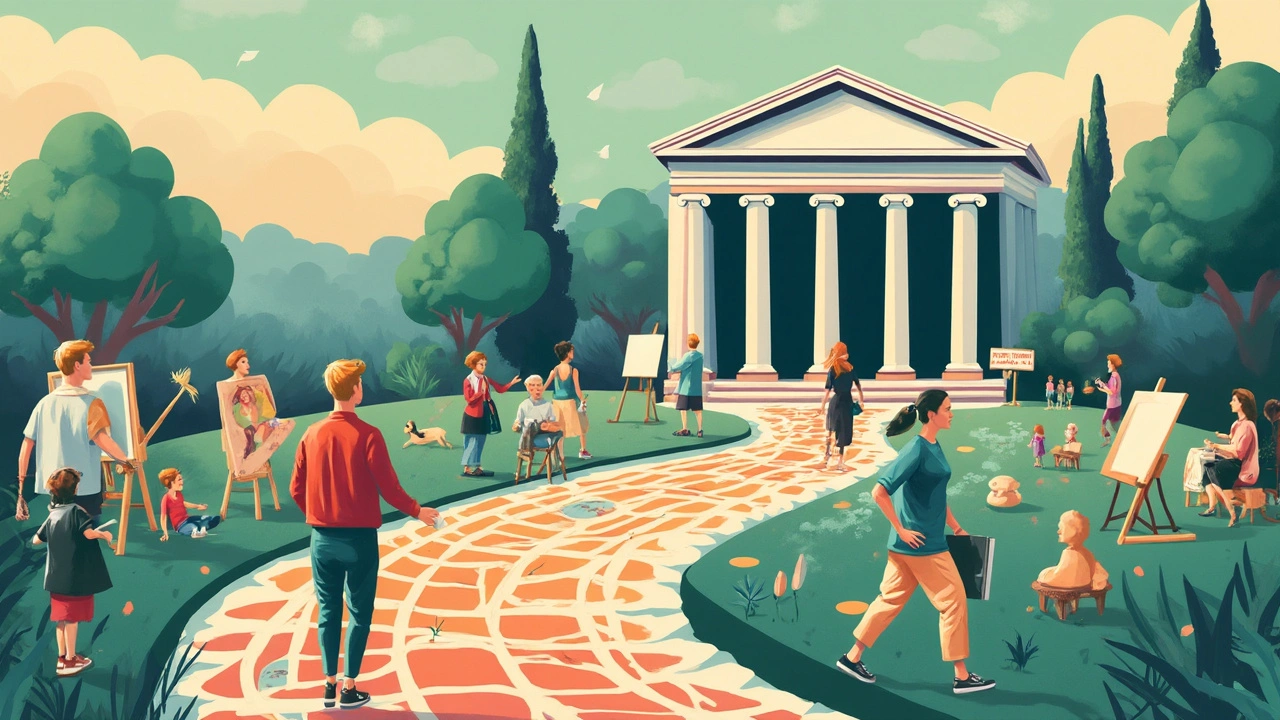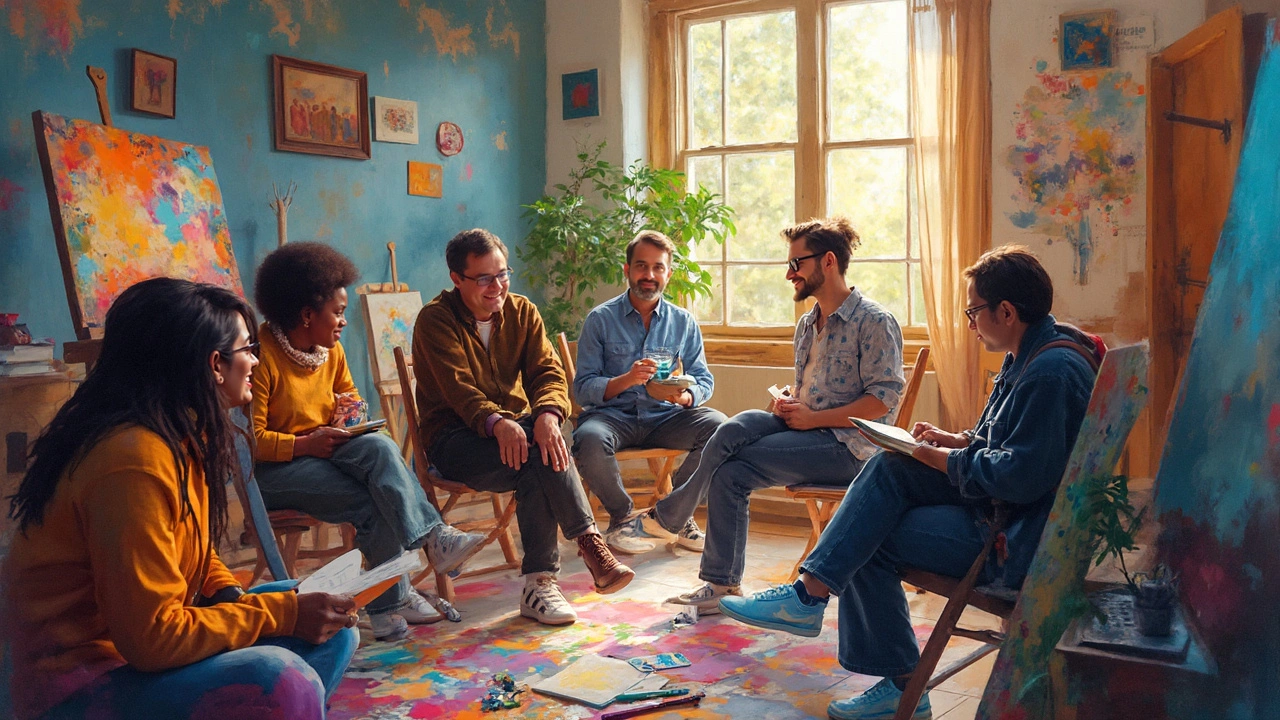How an MFA Fits Into the PhD World
You might be surprised how many people with an MFA toy with the idea of going for a PhD. After all, plenty of universities pitch the MFA as the “terminal degree” for artists and writers. So what gives? Can you really take that hands-on arts-focused qualification and turn it into a springboard for doctoral studies? The answer is a solid yes—but there are twists no one tells you about at those MFA open days.
First, let's smash the myth: having an MFA absolutely does not lock you out of PhD programs. Most arts and humanities PhDs—like English literature, film, theatre, or creative writing—accept candidates with MFAs. In fact, in the US, a creative writing PhD almost expects you to have an MFA in your back pocket. The MFA’s reputation for “terminal degree” status mostly just means you’re qualified to teach at the university level or be recognized professionally, not that you’re forever done with higher education. There’s no academic police stopping you from enrolling in a doctorate if you meet the entry criteria.
Here’s the reality: admissions for PhDs are more about your portfolio, research ideas, and potential to contribute new knowledge than about the precise label on your previous qualification. In New Zealand, for example, the University of Auckland’s PhD in Creative Practice encourages applicants with MFAs. In the US, creative writing PhDs at big schools like USC and University of Houston welcome MFAs—sometimes, they even prefer them. Across the UK and Australia, the rules are similar. The MFA often ticks the ‘research capable’ box, assuming you did some kind of thesis or final project. It’s about the depth of your previous work, not whether you ticked the “Master of Arts” or “Master of Fine Arts” box.
But here’s a curveball: outside the creative fields, the MFA-to-PhD pipeline isn’t as straightforward. If you dream of a PhD in philosophy, linguistics, or art history, an MFA in painting might not smooth your path. Admissions committees in these more academic areas may prefer a scholarly MA, simply because those programs dig deeper into research theory and method. That said, exceptions pop up all the time. I once met someone who parlayed their MFA in ceramics into a PhD in anthropology after convincing a supervisor that their studio project was an ethnographic study in disguise.
The trickiest part is that every university is a little different. Some departments love the mix of creative and academic backgrounds the MFA brings; others want proof you’ve mastered traditional academic research. This “patchwork” approach can be liberating, but also confusing if you don’t check the fine print before you apply. Details like whether your MFA required a written thesis, if your marks are up to snuff (often a B+ average or higher), or if you have research references matter.
One more messy bit: in sciences or business fields, an MFA rarely counts as a stepping stone to a PhD. But if you deepen your MFA with research, or piggyback it with a research-focused Master’s, you could slip through unusual doors. The system isn’t as rigid as it looks, but you need to be clever—and tenacious—to navigate it.

What PhD Committees Look For (and How MFA Graduates Stack Up)
Let’s get under the hood and see what actually happens when you hit ‘submit’ on that PhD application. Is an MFA going to help or hurt? What are admissions teams really eyeballing?
The first thing to know: research chops matter—a lot. Even in creative PhD fields, they want evidence that you know how to formulate a research question, dig for sources, analyze, and communicate your findings clearly. If your MFA included a major written thesis or exegesis, this plays in your favor big time. Another insider tip: some universities will let you fast-track into a PhD if your MFA was research-intensive or included a publication-worthy dissertation. (In New Zealand and Australia, this is surprisingly common.)
But not all MFAs are alike. If your MFA was mostly about studio time, performance, or production, with little academic writing, you’ll need to show your scholarly muscle another way. Maybe you published essays, gave talks, or worked in a research team. Don’t be shy—put it all in your application. Strong references from academic supervisors are gold. So are publication credits, conference presentations, or residencies that had a research focus.
Here’s a kicker that trips up a lot of creative folks: you’ll need to swap out that portfolio mindset for something more research-oriented. Your application essay should not just show what you’ve made, but frame your practice as an investigation that can push boundaries in your field. Think about questions you want to answer or problems you want to solve—not just projects you want to build or poems you want to write.
Some PhD programs in creative fields actually offer a practice-led PhD, where half or more of the doctorate is your creative work, but the other half is a written exegesis putting that work in a research context. The UK, Australia, and parts of Europe lead the way here. The US is catching on, but slower.
| Country | Practice-Led PhDs Available | MFA Requirement |
|---|---|---|
| USA | Yes (in creative writing, theatre, visual arts) | Preferred, not always required |
| UK | Yes (widely in arts) | Accepted; MA also fine |
| Australia/NZ | Yes (creative practice common) | MFA or research MA required |
If your MFA came with high academic marks (think First Class or Distinction in the UK and Commonwealth, or a GPA of 3.5/4 or above in North America), you’re on safe ground. But admissions teams also love to see curiosity—a hunger to dig deep, take risks, and make meaningful contributions to your field. If you can show evidence of this (maybe through community projects, large-scale exhibitions, or collaborative work with research aims), you’ll stand out even if your transcript isn’t perfect.
A few practical tips for MFA grads aiming for PhDs:
- Build a strong research question or project that fits within what the target PhD program offers.
- Seek out potential supervisors and have real conversations before you apply. Many programs expect this before you submit your full application.
- Frame your creative practice in academic terms. Connect your artmaking or writing to existing scholarly debates.
- Show that you can handle long-form academic writing. If possible, get a chapter or article published or presented at a scholarly conference as evidence.
- Highlight teaching, mentoring, or project management experience. PhDs value independent, self-motivated workers who can also contribute to the academic community.
If you don’t see your exact MFA field represented among the faculty in your dream PhD program, don’t lose heart! Interdisciplinary research is all the rage right now, so if you can make a case for your unique angle (say, combining visual art with digital tech or creative writing with activism), admissions teams may be keen.
Amazing fact: The National Endowment for the Arts in the US found that more than 15% of academically-employed visual artists and writers had doctorates in 2022, up from less than 5% a decade prior. So the idea that MFAs are academic dead ends is totally outdated—the real question is how you pitch your story.

Making the MFA to PhD Leap: Smart Moves and Unofficial Wisdom
Ready to make the MFA-to-PhD jump? Here’s where the rubber meets the road. It’s not just about ticking off eligibility boxes—it’s about telling a compelling story and proving you’ll thrive in the intensity of doctoral research. People who make this transition well do a few things differently.
First: build relationships. Many successful MFA graduates looking at PhDs start laying the groundwork a year or two before they apply. They email future supervisors, ask for feedback on project ideas, visit campus research days, or attend public lectures to meet people. When the admissions committee sees your name, you don’t want to be just another faceless application. You want someone to think “Oh, there’s that artist who asked the wicked question about hybrid genres at the panel in April!”
Second: be upfront about your strengths and learning curves. If your MFA didn’t involve much traditional research, own that in your statement, then show what you’ve done to fill in the gaps. Maybe you took an extra research methods course, or completed an archival project, or collaborated with academics on community-engaged work. Show you’re evolved and adaptable—it matters more than you think.
Third: get practical about funding. In New Zealand (and much of Australia and the UK), domestic and even international PhD students can get most of their fees covered—sometimes even a living stipend, especially for Māori and Pasifika students who are underrepresented in doctoral study. In the US, funding is patchier but many reputable creative PhD programs do offer full or partial scholarships. Check deadlines and requirements well in advance; it’s not uncommon for funding applications to be due six to nine months before the PhD program’s final cut-off date.
Fourth: know that some doors close as you specialize, but new doors open too. If you stay in a highly niche MFA field, your best match is usually PhDs that value practice-led research. But if you can bridge your skills into emerging areas—think digital humanities, climate change art, or arts-based social research—you’ll unlock entire new worlds of doctoral study that yesterday’s applicants couldn’t even dream about.
Here’s one thing few people talk about: the mental side. Going from an MFA’s collaborative, critique-driven vibe to a PhD’s solitary research grind can feel weird. You’ll need tenacity, self-discipline, and strategies to survive the ‘long haul’ years of reading, writing, and re-writing. But the perks are huge—access to funding, travel, teaching opportunities, and a platform for your voice. A PhD can let your creative work reach new audiences and even influence policy, curriculum, or community life.
Let’s not sugar-coat things: the MFA-to-PhD journey isn’t for everyone. But if you love ideas as much as making, and you have a burning question you’re dying to answer, it’s a legit and rewarding route. Start with careful research, honest self-assessment, and the willingness to ask for help along the way. Don’t assume the MFA is a finish line. For some of us, it’s just the warm-up lap before the real race begins.


Comments
rahul shrimali
This is a solid topic. An MFA can definitely be a path to a PhD, depending on the field and program. Many creative disciplines value practice-based research, so your MFA experience can be a big plus.
But it can also depend a lot on the university's specific requirements and how your prior work fits their academic goals. It's not like a straight switch, but with the right proposal and portfolio, you can make a strong case.
Also, knowing how to articulate your artistic practice in an academic language is crucial. You can't rely only on art skills; showing research rigor matters too.
It'd be great if the article shared more concrete examples or success stories from people who made the jump.
Anyone here tried going from MFA to a PhD? What hurdles did you find?
Eka Prabha
While I acknowledge the potential fluidity between an MFA and PhD track, I must question the complacency that this perception fosters. The academic gatekeeping mechanisms are primed to privilege conventional intellectual pursuits over creative degrees.
Many institutions cling resolutely to the traditional valorization of doctoral candidates originating from more canonical liberal arts or science-based master's programs. This perpetuates a systematic marginalization of MFA holders that aspiring applicants must navigate with strategic caution.
Fear not the public narrative; rather, scrutinize the implicit biases inscribed in admission processes. The key lies in understanding both overt criteria and covert prejudices underpinning selection committees' decisions.
Therefore, artistic candidates should proactively curate portfolios that not only emphasize creativity but also demonstrate robust theoretical engagement, methodological rigor, and cultural critiques aligning with scholarly expectations.
Does anyone else apprehend this as a structural barrier rather than isolated difficulty?
sumraa hussain
Yeah, the whole MFA to PhD journey is kinda like walking a tightrope with a paintbrush in your hand. There’s the creative freedom part, then the academic grind.
Most PhD programs want research proposals that fit their scholarly mold, but the MFA world thrives on experimentation and personal voice — that might clash a bit.
However, some schools are more progressive, embracing practice-led research and combining creative work with theoretical frameworks.
So, it’s really about finding institutions that value your kind of approach. And clearly articulating how your creative practice contributes new knowledge.
What’s cool is that this blurring of lines can produce innovative scholarship, which enriches the academic field as a whole.
Raji viji
Look, let’s get real here. The whole MFA to PhD pipeline is riddled with academic politics and gatekeepers who don’t appreciate the colorful chaos that true artists bring.
Some institutions treat the MFA like a half-baked stepchild of higher ed, undervaluing the blinding creativity in favor of dry, stale theoretical models.
You gotta be cunning, maybe even a bit ruthless, and tailor your applications to speak the ‘academic language’ that these committees drool over.
Don’t fall for the fluff! It’s a brutal game of who knows how to brand their art as serious research.
So, MFA holders dreaming of a PhD should prepare for a battle of wits, not just talent.
Rajashree Iyer
The very prospect of transitioning from an MFA to a PhD program stirs a profound reflection on the intersection of tacit knowledge and formal understanding.
Is the PhD path not the ultimate pilgrimage into the sanctified realms of explicit epistemology, while the MFA remains anchored in the ineffable whispers of creative impulse?
Perhaps, this journey is less about institutional approval and more a quest to reconcile the dialectical tension between creation and critique.
To pursue a doctoral program after an MFA is to navigate between worlds, where the poet meets the philosopher, and the artist becomes scholar and vice versa.
Does this synthesis not challenge the very nature of knowledge production?
Parth Haz
Great article that sheds light on a frequently misunderstood academic path! It’s always encouraging to see creative professionals considering further research opportunities through PhDs.
The key takeaway for me was the emphasis on aligning your MFA experience with research expectations and boosting your application with a strong academic proposal.
It's definitely possible but requires careful planning, and maybe some bridging coursework or publications where applicable.
I’d love to hear if anyone faced challenges related to funding or supervisor matches along this path?
Overall, embracing interdisciplinary approaches can only enrich the academic community further, so more power to MFA holders stepping into PhD programs.
Vishal Bharadwaj
Honestly, this whole notion that an MFA might be less than adequate preparation for a PhD is pretty overrated. Most CFA and fine arts pathways are seriously intense and demand critical thought, even if it’s not the chalk-and-talk kind.
One thing that gets overlooked is how many of these programs have flexible criteria. So, it’s about selling your artistic inquiry as valid research.
But of course, some universities have rigid frameworks that totally ignore practice-led research, which is just a dumb bureaucratic stance.
Anyone got tips on navigating admission committees that are stuck in their old ways?
anoushka singh
Wow, I never thought about the MFA to PhD route this deeply before. I guess it makes sense that it’s not just about having an MFA but how you frame your artistic work academically.
Though, I wonder how much bias applicants face—do PhD programs really evaluate all creative fields equally?
I also think confidence and clear communication are huge factors when you pitch your research plan and portfolio.
And yeah, funding must be tricky too. Most grants seem aimed at more traditional disciplines.
It’d be nice if the post talked more about financial support or mentorship options for MFA folks going for PhDs.
Jitendra Singh
Reading all this makes me think the MFA to PhD path is what you make of it — your approach, persistence, and how well you connect your creative work to academic conversations.
Personally, I think being open-minded about crossover ideas and collaborating with scholars from diverse backgrounds can enhance your proposal.
Also, recognizing that some rejection is part of academic life helps build resilience.
I’m curious if anyone has experience with interdisciplinary PhD programs that welcome MFA applicants with open arms?
Madhuri Pujari
Oh please, does anyone really believe the MFA is a passport to a PhD without serious hand-holding? The systemic elitism in academia is blatant, and MFA grads are often treated like second-class citizens.
Most applicants probably won’t even get a look unless they dumb down their creativity to fit boring academic molds.
This post glosses over the unpleasant realities of academic gatekeeping and cultural capital hoarding.
Call me cynical, but the notion that MFA leads cleanly into doctoral study is more fantasy than fact.
Anyone else sick of these sugarcoated success stories?